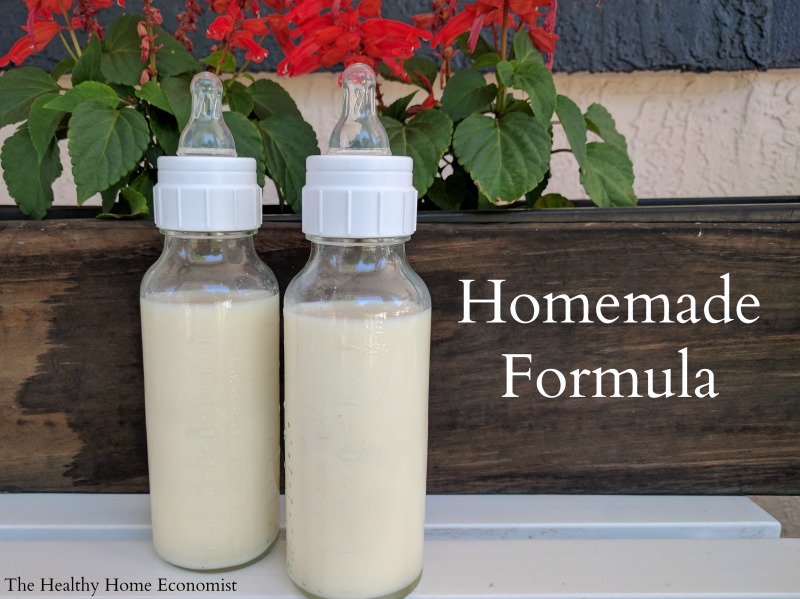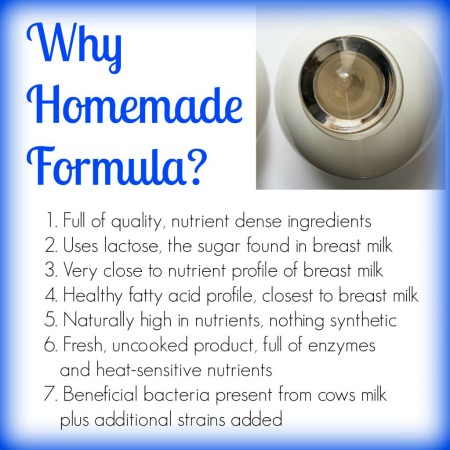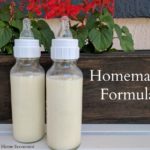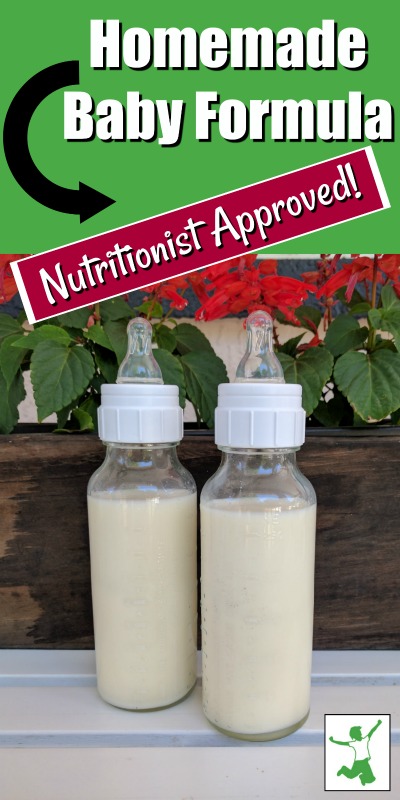Table of Contents[Hide][Show]
A nourishing homemade baby formula using safe, whole ingredients. This recipe was developed and tested by Dr. Mary Enig, a PhD Nutritionist and originally published in Nourishing Traditions cookbook in 1996. It was formulated to match breastmilk as closely as possible and is also suitable for infants. Source: Weston A. Price Foundation

There is no doubt that breastfeeding your baby is the best option for the child’s long-term health and development. Human breastmilk from a well-nourished mother is the perfect food for baby. However, in circumstances where the child is adopted or the Mother finds herself unable to breastfeed, formula feeding becomes necessary. In those cases, homemade baby formula is best.
Using a baby formula recipe that closely matches the nutritional profile of breastmilk is a far better choice than even organic baby formula from the health food store. More on this below.
Note: Donor programs are widely available for human breastmilk. But, the diets of the donor mothers are unknown and most likely nutritionally insufficient. In addition, breastmilk banks pasteurize the donated breastmilk which destroys much of the nutritional benefit. Unless you are fortunate to have a trusted and direct donor milk source in your community, avoid this option!
Dangers of Commercial Formula
Commercial formulas are always a poor choice for a number of reasons. First of all, formula manufacturers line the cans with the chemical BPA. This substance disrupts hormone development and is a probable contributor to early puberty in girls, and ADHD, urogenital abnormalities, and other ills in boys.
The European Food Safety Authority found that canned commercial formula is a significant source of BPA for infants, exposing the child to 13mcg of BPA per kg of body weight per day! BPA-free formula cans are no better. The chemical BPS is typically used instead which is just as dangerous.
Beware that manufacturers pack even organic commercial formula like Earth’s Best in BPA cans. Worse, they use organic brown rice syrup as the primary sweetener which is known to be frequently contaminated with arsenic.
In addition, all commercial milk formulas are processed at extremely high temperatures which violently denature the fragile milk proteins, render them allergenic, and add carcinogens to the final product. Soy infant formula is the worst. Obscenely high processing temperatures not only denature the proteins but large levels of phytic acid in soy block mineral absorption by the infant. Moreover, soy-based plant estrogens disrupt the hormonal development of the baby!
It seems that for the concerned Mother who is unable to breastfeed, learning how to make baby formula at home with safe, pure ingredients is the most prudent way to go!
Why Make Homemade Formula Even if You Are Breastfeeding
In the video below, I show you how to make your own safe, healthy raw milk homemade formula for your baby.
The recipe I follow was originally published in the cookbook Nourishing Traditions in 1996 and developed by Dr. Mary Enig.
Even though I breastfed each of my children for at least 2 years, I made this exact formula for my own children when I was away for the day or the evening as pumping was not an option that worked well for me.
I even used this homemade formula for an entire day once when I had some dental work done and was advised to pump and discard for 24 hours.
As a result, even successfully breastfeeding Moms can use this wonderful homemade formula as a supplement when necessary to their own nutrient-dense breastmilk!
It is advised that even breastfeeding Mothers have the ingredients for this formula on hand for an emergency. If Mom is sick or otherwise unable to nurse, Dad can step in and make this safe alternative until Mom is back on her feet. It takes a few days to a week to gather all the ingredients together to make this formula, which is why I advise having them on hand at all times.
Homemade Most Nutritious
The image below lists the reasons why it is worth it nutritionally to make formula yourself for your precious baby!
You can order all of the required ingredients for the homemade baby formula in one package from this reputable, vetted source.
Moms who have successfully used this formula feeding your children, please post about your experience in the comments section to encourage those who are considering it and need some Mom to Mom encouragement!

Where to Source Quality Milk
The most widely available grass-fed milk around the world is from cows. This is usually the most budget-friendly and easily sourced milk for this recipe for homemade formula.
If only goat milk is available in your area, this recipe for goat milk baby formula can be used instead. When using milk from ewes, please refer to the linked article for an adjusted recipe; one of the benefits of sheep milk is that it is higher in healthy fats than either goat or cow milk.
Camel milk formula is another option that is a particularly digestible form of dairy and growing in popularity around the world.
Alternatively, you can use low temp (vat) pasteurized, non-homogenized whole milk cultured with a piima or kefir starter. Then substitute the piima milk or kefir for the raw milk portion of the formula recipe. Cold-pressed raw milk also must be cultured before using it as it contains no probiotics.
Do NOT use ultrapasteurized (UHT) milk even if organic as it is too highly processed and extremely allergenic!
It is also best to avoid all types of powdered milk for this recipe. The factory process of making milk powder reduces nutrition considerably and denatures it, which makes it more likely baby will have an allergic reaction.
Dairy Allergy Option
If all types of dairy prove unsuitable for your baby, make this nondairy baby formula recipe instead. It uses a base of homemade bone broth as a substitute for milk. It is important not to utilize a plant-based or otherwise vegan baby formula recipe.
Avoid buying bone broth to make the dairy-free formula. Make it yourself! Manufacturers of commercial bone broth, even if authentic, may water down the end product. This is apparent if it does not gel when chilled in the refrigerator.
Many brands have toxic packaging issues as well. If you must buy it in a pinch, see my shopping guide page for vetted brands that are safe.

Homemade Baby Formula Recipe (for infants too)
A nourishing baby formula recipe you can make at home with safe, whole ingredients developed and tested by a PhD nutritionist to match breastmilk as closely as possible. Also suitable for infants.
Ingredients
- 2 cups raw cow milk OR organic whole milk yogurt
- 1 7/8 cups filtered water
- 1/4 cup liquid whey
- 4 Tbl lactose
- 1/4 tsp Bifidobacterium infantis powder
- 2-4 Tbl raw or pasteurized cream
- 1/2 tsp cod liver oil unflavored
- 1/4 tsp butter oil unflavored
- 1 tsp sunflower oil preferably organic
- 1 tsp extra virgin olive oil preferably organic
- 2 tsp virgin coconut oil preferably organic
- 2 tsp nutritional yeast
- 2 tsp gelatin
- 1/4 tsp acerola powder
Instructions
-
Fill a 2 cup Pyrex measuring cup with filtered water and remove 2 TBL (this will give you 1 7/8 cup water).
-
Pour about half the water into a pan and turn burner on medium.
-
Add the gelatin and lactose and let dissolve, stirring occasionally.
-
When gelatin and lactose are dissolved, remove pan from heat and add the rest of the water to cool.
-
Stir in the coconut oil and butter oil until melted.
-
Put remaining ingredients in a glass blender.
-
Add the water mixture and blend for about 3 seconds.
-
Place formula in glass baby bottles or a glass jar and refrigerate.
-
Before giving to baby, warm glass bottle in a pan of hot water or a bottle warmer. NEVER microwave baby bottles!
Recipe Video
Recipe Notes
If using raw cow milk from holstein cows, use 4 Tbl of extra cream (otherwise use 2 Tbl extra cream).
If choosing to make this homemade formula with camel milk, be sure to include 4 Tbl extra cream as camel milk is lower in cream than cow milk.
Do not use high oleic sunflower oil. Use only the brand recommended in the ingredients list which is cold pressed, organic, unrefined, and low oleic.
*Do NOT use powdered whey from the store as it is denatured. Avoid whey from making cheese as it will curdle the formula.
*Do not substitute pasteurized or powdered milk as these are heavily processed, denatured and allergenic foods.
*Do NOT use ultrapasteurized (UHT) cream. It is highly allergenic. Raw or pasteurized cream is acceptable.
*Do NOT use fish oil or krill oil instead of high vitamin cod liver oil as they do not contain any Vitamin D and very little to no Vitamin A.
Collagen powder may be substituted for the gelatin in a pinch (more on peptides in baby formula in this article).
If you are wondering where is the iron in homemade baby formula, this article provides an explanation.
If baby experiences constipation using this formula, try adding 1 tsp of molasses to each batch. This should help move things along.
How to Transition to DIY Formula
Once you’ve viewed the video, gathered the ingredients, and made your first batch, how do you feed it to your baby for the first time?
It is important not to switch all at once as this can cause gas, excessive spit-up, or an uncomfortable change in diaper habits such as constipation or overly loose stools.
Start by giving your baby three-quarters of the old formula blended with one-quarter of the homemade. Try this ratio for a day or two and see how your infant responds.
If no digestive upset or major change in diaper habits occurs, increase the amount to a 50-50 blend of old formula to homemade. Observe for another day or two as before.
If no major issues, increase once again to three-quarters homemade formula to one-quarter old formula. If baby does well on this blend for a third time, you are ready to fully transition to the homemade formula.
At any time during the transition, symptoms of intolerance emerge, back up to the previous successful blend ratio and stay there for a day or two before attempting to increase once again.
Homemade Formula FAQ
Weston Price Foundation
Feeding an Adopted Baby
Traveling Tips with Baby Formula Made at Home
Iron in Baby Formula
Collagen Peptides instead of Gelatin for Homemade Formula?










Thank you so much. If only there were more people like you!
I don’t understand why some don’t like to listen.
I don’t understand why many say they can’t breastfeed, maybe a few can’t yes, what are the reasons?
Some don’t like spending time looking for what’s better for their child and just want to listen to their friends!
So thankful I found this recipe after all store-bought formulas hurt my son’s stomach! I had to have a C-Section, and my breast milk didn’t come in for four days. Even then, I didn’t produce much. My son would cry after drinking formula.
I started using this recipe with local raw milk about a month ago, and he has had zero digestion problems. He is vibrant and healthy. So grateful:)
And also, I didn’t notice when I was buying, but instead of nutritional yeast flakes, I bought nutritional yeast powder? It’s ok to use still right?
Yes, that is fine … please get the brand recommended in the post though so it doesn’t have folic acid (synthetic) in it.
If you need to make a formula fast, and no time to wait the 24 hr. for the milk to culture, can you use a whole-milk grassfed yogurt from the store.
About how much does it cost to aquire the ingredient all together for this formula?
The formula ingredients cost just under $4 per day. This includes ordering online with shipping charges or when purchased locally with sales tax. **This does not include the cost of the milk and cream, which varies widely depending where you live.
To compare, Similac costs around $4 per day, including average local sales tax.
Overall, the cost of making a quality homemade formula including the grassfed milk and cream will be higher. However, in the long run it is much cheaper considering the typical health challenges and subsequent medical costs that come with feeding babies conventional formula.
Dear Sarah – Thank you for this informative article. Is it possible to purchase these ingredients in bulk? If so, what is a reputable distributor? Also, if we were interested in premixing the ingredients and storing the formula in their powdered form are there substitute ingredients (for the coconut oil for example) where one could simply add warm water as with commercial formulas? Do you have any recommendations for that? – Best MC
You absolutely CANNOT powderize and store this formula. That would destroy the nutritional benefits and render it unhealthy and allergenic. Please make it FRESH every day or two as directed. It was developed by a PhD nutritionist to mimic breastmilk as closely as possible. Do not make any substitutions or changes other than the ones outlined in the recipe above.
The distributor for all of the ingredients except the fresh milk/cream is http://www.radiantlifecatalog.com/product/nourishing-traditions-kit-homemade-baby-formula/baby-child-care/?a=58537
Sorry to contradict Sarah, but OF COURSE you can “in a pinch”! If your baby is hungry, feed him the best you can–don’t make him wait for your kefir to culture or to get yogurt from the store. And seriously, these products (yogurt, kefir) are *soured*. What about the sugar the bacteria has eaten? Why doesn’t anyone mention adding extra lactose?
You can always get some organic whole milk plain kefir from the store in a pinch. You should never use pasteurized uncultured milk! The kefir from the store isn’t cultured for 24 hours like it should be, but at least it is cultured.
It’s not the reduction in milk sugar (lactose) that is the issue with using kefir over pasteurized milk “in a pinch”, its the fact that there are zero enzymes and probiotics to help baby digest. THAT is why kefir or yogurt MUST be used if raw milk is not available. NEVER pasteurized milk.
Hello, Sarah,
Do you have any advice about a waste-free, efficient method one can use to procure the cream and whey at home? For example, if I let the milk sit, then pour off the cream (I won’t be able to do this in an exacting manner but I assume that’s ok), and make a lower-fat yogurt with it (for my husband and I to consume), straining the yogurt for the whey? About how many liters of milk would I need per week for just this process?
Another thing, I’ve found it very strange to read that one can replace the milk with yogurt, etc., or that if one only has pasteurized milk one must culture it. Obviously, these are ferments and hence contain less sugar. But nobody mentions the need to add more lactose. That is obviously problematic; it needs to be addressed. Milk and milk kefir are two very different things.
You can use a turkey baster to very efficiently suck off the cream from the top of the milk. HOWEVER, this milk with the cream removed SHOULD NOT be used for the formula. Use milk that has all the cream intact and then add the additional cream. Use the milk that you’ve skimmed the cream off for something else .. not baby formula.
Yes, you can use the skimmed milk to make lowfat yogurt and then strain the whey from it to use for homemade formula. That is fine.
It’s not the reduction in milk sugar (lactose) that is the issue with using kefir or yogurt over pasteurized milk “in a pinch”, its the fact that there are zero enzymes and probiotics to help baby digest. THAT is why kefir or yogurt MUST be used if raw milk is not available. NEVER pasteurized milk.
Hi Sarah,
Can this formula be used from 0-12 months? If not, what changes do i have to make for each month?
How long can this formula stay in the freezer? Can i make the batch and freeze in freezer-safe bottles or brrastmilk bags, then thaw in the fridge?
Yes, this formula is appropriate from birth to age 1.
Hi Sarah, thank you for taking the time to answer all of my questions!
I’m reading through the list of ingredients from radiant life and one that isn’t included is whey. I saw your video on making whey and I was wondering if I can substitute anything in place of the whey or purchase whey from radiant life?
Thanks again for everything! We did make a small test batch with no whey and it turned out awesome!
Unfortunately, you cannot purchase whey. Whey powder is not an acceptable substitute and has none of the benefits of liquid whey.
You can make it from raw milk or even store bought organic yogurt (how-to videos for both on this blog). Some small dairy farms sell whey … mine does so ask around!